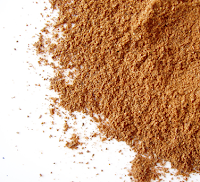Christopher Columbus discovered allspice in the Caribbean. Although he was seeking pepper, he had never actually seen real pepper and he thought allspice was it. He brought it back to Spain, where it got the name "pimienta," which is Spanish for pepper. In much of the world, allspice is called pimento because the Spanish mistook the fruit for black pepper, which the Spanish called pimienta
Allspice is the only spice that is grown exclusively in the Western Hemisphere. Allspice is available whole or ground.
Culinary Uses
Allspice can be used as a substitute, measure, for cinnamon, cloves or nutmeg.
Jerked meats like pork, chicken and kid reflect the Spanish/Jamaican background of Allspice.
It is a particularly popular spice in European cooking, an important ingredient in many marinades, pickling and mulling spices.
Many pâtés, terrines, smoked and canned meats include allspice. It is also used in liqueurs.
Medicinal Uses
Allspice provides relief for digestive problems because the volatile oil contains Eugenol, a weak antimicrobial agent.
It is also carminative in nature as it also contains an oil rubefacient, meaning that it irritates the skin and expands the blood vessels, increasing the flow of blood to make the skin feel warmer.
The tannins in allspice provide a mild anesthetic that, with its warming effect, make it a popular home remedy for arthritis and sore muscles, used either as a poultice or in hot baths.


No comments:
Post a Comment